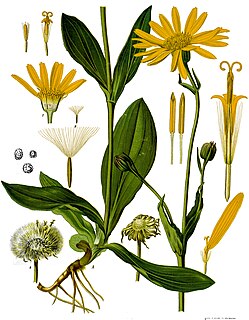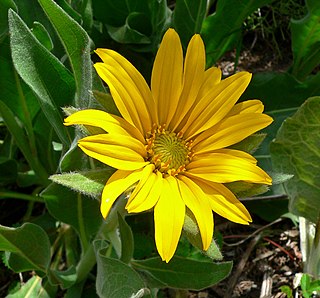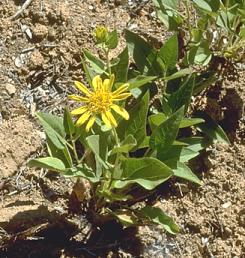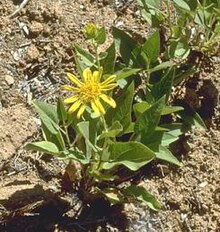
Solidago, commonly called goldenrods, is a genus of about 100 to 120 species of flowering plants in the family Asteraceae. Most are herbaceous perennial species found in open areas such as meadows, prairies, and savannas. They are mostly native to North America, including Mexico; a few species are native to South America and Eurasia. Some American species have also been introduced into Europe and other parts of the world.

Arnica is a genus of perennial, herbaceous plants in the sunflower family (Asteraceae). The genus name Arnica may be derived from the Greek arni, "lamb", in reference to the plants' soft, hairy leaves. Arnica is also known by the names mountain tobacco and confusingly, leopard's bane and wolfsbane—two names that it shares with the entirely unrelated genus Aconitum.

Scorzonera is a genus of flowering plants in the dandelion tribe within the daisy family.

Gerbera L. is a genus of plants in the Asteraceae (Compositae) family. The first scientific description of a Gerbera was made by J. D. Hooker in Curtis's Botanical Magazine in 1889 when he described Gerbera jamesonii, a South African species also known as Transvaal daisy or Barberton daisy. Gerbera is also commonly known as the African daisy.

Wyethia is a genus of North American flowering plants in the family Asteraceae.

Balsamorhiza is a genus of plants in the family Asteraceae known commonly as balsamroots. These are perennials with fleshy taproots and caudices bearing erect stems and large, basal leaves. Atop the tall stems are showy yellow sunflower-like blooms. Balsamroots are native to western North America.
Mules ear is a common name for a group of plants in the sunflower family (Asteraceae) which were previously all placed in the genus Wyethia, but are now classified in the following genera:

Kleinia petraea is a species of flowering plant in the genus Kleinia and family Asteraceae which was previously considered to be a species of Senecio. Native to Kenya and Tanzania, it is colloquially known as creeping jade, trailing jade or weeping jade due to its resemblance to the unrelated Jade plant. It is grown as a garden plant as a groundcover or in hanging baskets.

Wyethia helenioides is a species of flowering plants in the family Asteraceae commonly referred to as gray mule's ears or whitehead mule-ears.
Agnorhiza bolanderi is a species of flowering plant known by the common name Bolander's mule's ears. It is endemic to California, where it is known only from a narrow section of the Sierra Nevada foothills about 275 kilometers long from Shasta County to Mariposa County. It grows in chaparral and grassland habitat, usually on serpentine soils.

Agnorhiza reticulata, known by the common name El Dorado County mule's ears, is a rare species of flowering plant found only in a small region of north-central California.
Agnorhiza elata is a species of flowering plants known by the common name Hall's mule's ears. It is endemic to California, where it is known only from a section of the central Sierra Nevada foothills. It occurs primarily in a region stretching from Tuolumne County to Fresno County, but a few isolated populations have been found in Tulare County.
Agnorhiza invenusta is a species of flowering plant known by the common names Coville's mule's ears and rayless mule's ears. It is found only in California, where it grows in the Sierra Nevada foothills as in Fresno, Tulare, and Kern Counties.
Agnorhiza ovata is a species of flowering plant known by the common name southern mule's ears. It is native to the mountains and foothills of southern California and Baja California, occurring the Coast Ranges and Sierra Nevada foothills in Tulare, Kern, Ventura, Los Angeles, Orange, Riverside, and San Diego counties in California, with additional populations in the Peninsular Ranges south of the international border.

Crassula ovata, commonly known as jade plant, lucky plant, money plant or money tree, is a succulent plant with small pink or white flowers that is native to the KwaZulu-Natal and Eastern Cape provinces of South Africa, and Mozambique; it is common as a houseplant worldwide. Much of its popularity stems from the low levels of care needed; the jade plant requires little water and can survive in most indoor conditions. It is sometimes referred to as the money tree; however, Pachira aquatica also has this nickname.

Scabrethia is a genus of North American flowering plants in the family Asteraceae.
Asanthus squamulosus is a North American species of plants in the family Asteraceae. It is native to northern Mexico, and the southwestern United States. Common name is Mule Mountain false brickellbush.

Brunnichia ovata is a species of the buckwheat family that is found in North America. It was reassigned from the genus Rajania to Brunnichia by Lloyd Shinners in the publication Sida in 1967. Formerly it had been placed in Rajania by Thomas Walter in Flora Caroliniana in 1778. Brunnichia ovata plants grow near riverbanks, the perimeters of lakes, wet woods and thickets. This species is found in the buckwheat family, Polygonaceae. Brunnichia ovata is referred to by two other common names including American buckwheat vine and redvine.
Paul Graham Wilson is an Australian botanist. He has been a most prolific contributor to the journal Nuytsia, contributing to the first issue in 1970 and to the 12th volume in 1998, which was dedicated to him for his contributions to plant taxonomy and to celebrate his 70th birthday. Since his retirement from the Western Australian Herbarium in 1993, he has helped to maintain a comprehensive census of the flora of Western Australia.

Felicia is a genus of small shrubs, perennial or annual herbaceous plants, with 85 known species, that is assigned to the daisy family. Like in almost all Asteraceae, the individual flowers are 5-merous, small and clustered in typical heads, and which are surrounded by an involucre of, in this case between two and four whorls of, bracts. In Felicia, the centre of the head is taken by yellow, seldom whitish or blackish blue disc florets, and is almost always surrounded by one single whorl of mostly purple, sometimes blue, pink, white or yellow ligulate florets and rarely ligulate florets are absent. These florets sit on a common base and are not individually subtended by a bract. Most species occur in the Cape Floristic Region, which is most probably the area where the genus originates and had most of its development. Some species can be found in the eastern half of Africa up to Sudan and the south-western Arabian peninsula, while on the west coast species can be found from the Cape to Angola and one species having outposts on the Cameroon-Nigeria border and central Nigeria. Some species of Felicia are cultivated as ornamentals and several hybrids have been developed for that purpose.













